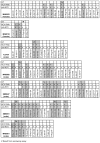Acute hepatitis C virus infection in young adult injection drug users: a prospective study of incident infection, resolution, and reinfection
- PMID: 19764883
- PMCID: PMC2821203
- DOI: 10.1086/605947
Acute hepatitis C virus infection in young adult injection drug users: a prospective study of incident infection, resolution, and reinfection
Abstract
Background: Hepatitis C virus (HCV) infection, clearance, and reinfection are best studied in injection drug users (IDUs), who have the highest incidence of HCV and are likely to represent most infections.
Methods: A prospective cohort of HCV-negative young IDUs was followed up from January 2000 to September 2007, to identify acute and incident HCV and prospectively study infection outcomes.
Results: Among 1,191 young IDUs screened, 731 (61.4%) were HCV negative, and 520 (71.1%) of the 731 were enrolled into follow-up. Cumulative HCV incidence was 26.7/100 person-years of observation (95% confidence interval [CI], 21.5-31.6). Of 135 acute/incident HCV infections, 95 (70.4%) were followed; 20 (21.1%) of the 95 infections cleared. Women had a significantly higher incidence of viral clearance than did men (age-adjusted hazard ratio, 2.91 [95% CI, 1.68-5.03]) and also showed a faster rate of early HCV viremia decline (P < .01). The estimated reinfection rate was 24.6/100 person-years of observation (95% CI, 11.7-51.6). Among 7 individuals, multiple episodes of HCV reinfection and reclearance were observed.
Conclusions: In this large sample of young IDUs, females show demonstrative differences in their rates of viral clearance and kinetics of early viral decline. Recurring reinfection and reclearance suggest possible protection against persistent infection. These results should inform HCV clinical care and vaccine development.
Conflict of interest statement
Figures





 ) show new acute HCV infections and reinfections. Participants whose first infection serology was consistent with previously resolved infection (anti-HCV positive and HCV RNA negative) are shown with gray stippled boxes (
) show new acute HCV infections and reinfections. Participants whose first infection serology was consistent with previously resolved infection (anti-HCV positive and HCV RNA negative) are shown with gray stippled boxes ( ).
).References
-
- Perz JF, Armstrong GL, Farrington LA, Hutin YJ, Bell BP. The contributions of hepatitis B virus and hepatitis C virus infections to cirrhosis and primary liver cancer worldwide. J Hepatol. 2006;45:529–38. - PubMed
-
- Micallef JM, Kaldor JM, Dore GJ. Spontaneous viral clearance following acute hepatitis C infection: a systematic review of longitudinal studies. J Viral Hepat. 2006;13:34–41. - PubMed
-
- Thomas D, Astemborski J, Rai R, et al. The natural history of hepatitis C virus infection: host, viral, and environmental factors. JAMA. 2000;284:450–56. - PubMed
-
- Santantonio T, Medda E, Ferrari C, et al. Risk factors and outcome among a large patient cohort with community-acquired acute hepatitis C in Italy. Clin Infect Dis. 2006;43:1154–9. - PubMed
-
- Wang CC, Krantz E, Klarquist J, et al. Acute hepatitis C in a contemporary US cohort: modes of acquisition and factors influencing viral clearance. J Infect Dis. 2007;196:1474–82. - PubMed
Publication types
MeSH terms
Substances
Grants and funding
LinkOut - more resources
Full Text Sources
Medical

